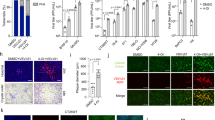Abstract
Purpose: Multidrug resistance (MDR) is a major obstacle in cancer chemotherapy. We examined whether cationic liposome-mediated transfer of a ribozyme could reverse MDR. Methods: A ribozyme which cleaved codon 196 of MDR1 mRNA was constructed from synthetic oligonucleotides. The MDR1 ribozyme was mixed with N-(1-(2,3-dileoyloxy)propyl)-N,N,N-trimethylammonium methyl sulfate (DOTAP) to form a liposomal complex. The complex was used to treat two P-glycoprotein-producing MDR cell lines: MCF-7/R human breast cancer cells resistant to doxorubicin and MOLT-3/TMQ800 human ALL cells resistant to trimetrexate (TMQ). In order to investigate the differential sensitivity of these two cell lines to the liposome-ribozyme complex, cellular pharmacological studies including phase-contrast and confocal microscopic studies were performed. Results: Treatment with the liposome-ribozyme complex resulted in reversal of vincristine (VCR) resistance in MCF-7/R cells, but not in MOLT-3/TMQ800 cells. In MCF-7/R cells the treatment resulted in decreases in MDR1 mRNA expression and P-glycoprotein production, whereas no changes in these parameters were seen in MOLT-3/TMQ800 cells. Phase-contrast microscopy revealed that in MCF-7/R cells treatment with DOTAP led to the formation of cytoplasmic vacuoles, and treatment with latex beads resulted in the development of a shiny material in the cytoplasm. In contrast, in MOLT-3/TMQ800 cells hardly any morphological changes occurred. Confocal microscopic imaging showed cytoplasmic fluorescence in MCF-7/R cells after treatment with DOTAP/FITC-dextran or FITC-conjugated latex beads. In MOLT-3/TMQ800 cells no fluorescence was detected. Treatment with cytochalasin B abolished fluorescence in MCF-7/R cells after treatment with DOTAP/FITC-dextran or FITC-conjugated latex beads. These studies show that MCF-7/R cells have high endocytotic activity whereas MOLT-3/TMQ800 cells have little activity. Conclusions: Endocytotic activity was correlated with the success of cationic liposome-mediated transfer of MDR1 ribozyme. Determination of endocytotic activity of target tumor cells may be predictive of efficacy of liposome-mediated gene transfer.
Similar content being viewed by others
Author information
Authors and Affiliations
Additional information
Received: 18 June 1997 / Accepted: 8 October 1997
Rights and permissions
About this article
Cite this article
Masuda, Y., Kobayashi, H., Holland, J. et al. Reversal of multidrug resistance by a liposome-MDR1 ribozyme complex. Cancer Chemother Pharmacol 42, 9–16 (1998). https://doi.org/10.1007/s002800050778
Issue Date:
DOI: https://doi.org/10.1007/s002800050778




